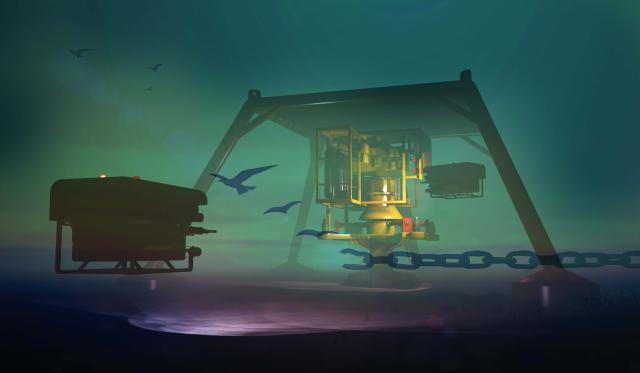
HOUSTON—An untethered structure has shown promise in reshaping offshore operations. To improve ROVs and the inspection, maintenance and repair (IMR) activities that they perform, a wireless solution called the uROV has been introduced.
“When you’re down there and see something interesting along your pipeline and want to go back to it, uROV gives you the ability to send down the adjustment of the commands so you get to start a new mission in the middle of a mission and it’s all live [streamed]. That’s really the beauty of supervised autonomy,” said Jack Vincent, a product champion at OneSubsea, a Schlumberger company, at the OTC session “Robotic Technology Enabling Future Offshore Operations” on Monday, May 6.
As a mix between the AUV and ROV framework, the supervised autonomous technology would not have to be piloted or rely on a preplanned mission.
“This is the idea that you have the best of both worlds. You have a fully autonomous vehicle that has everything, but you monitor everything that it does with supervised autonomy—that’s where the value comes in,” Vincent said.
Download the 2019 OTC Show Daily Newspaper: May 6; May 7
The design of the uROV is meant to target efficient deployment solutions, integrate advance sensing to the ROV platform and promote digital enablement.
“You could automate ROVs to make them a little more efficient, but most likely you’re not going to get the type of savings that you would with fully removing the vessel. That’s going to be a little bit more of a challenge,” Vincent said.
The uROV is a unique advancement that unlocks supervised autonomy through live video feedback prompting real-time solutions. Vincent said that unlike AUVs, the uROV platform achieves an optimal level of autonomy by balancing the system development cost with life-cycle operations and support cost.
“If you’re coming up to a drill center and you see the tree, in supervised autonomy you would want to stop before you reach it and have a little verification check before you go closer to manage your risks and make sure everything is in place before you start flying around the more sensitive equipment. This technology allows you to do that without having to guess based on time and position,” Vincent said.
While an AUV’s lack of real-time supervision is ideal in open water surveying, this is ineffective when producing subsea fields that require a different level of supervision, he pointed out.
“The advance sensing can be translated into an actual product that you give your clients that helps them have a better idea of the integrity of their equipment,” he said.
Vincent said the biggest advantage of the uROV is that it is a cost-reductive option by being untethered. The wireless communication cuts the dependency on an IMR vessel, thus cutting a huge cost to a company’s offshore operations.
Enabled by the vehicle platform, wireless communications, supervisory command and control, advanced sensing and perception, and digitalization tools and techniques, the uROV will be able to deliver the next-generation IMR service for customers, according to Vincent.
Mary Holcomb can be reached at mholcomb@hartenergy.com.
Recommended Reading
Dividends Declared Week of Nov. 4
2024-11-08 - Here is a compilation of dividends declared from select upstream and midstream companies in the week of Nov. 4.
TC Energy Appoints Two Independent Directors to Board
2024-11-07 - TC Energy Corp. appointed Independent Directors Scott Bonham and Dawn Madahbee Leach to its board, the company announced Nov. 7 in a press release.
OMS Energy Files for IPO, Reports Revenue Growth
2024-11-06 - Singapore-based OMS Energy, a wellhead system manufacturer, has not yet determined its price range and number of shares.
Record NGL Volumes Earn Targa $1.07B in Profits in 3Q
2024-11-06 - Targa Resources reported record NGL transportation and fractionation volumes in the Permian Basin, where associated natural gas production continues to rise.
Twenty Years Ago, Range Jumpstarted the Marcellus Boom
2024-11-06 - Range Resources launched the Appalachia shale rush, and rising domestic power and LNG demand can trigger it to boom again.
Comments
Add new comment
This conversation is moderated according to Hart Energy community rules. Please read the rules before joining the discussion. If you’re experiencing any technical problems, please contact our customer care team.





